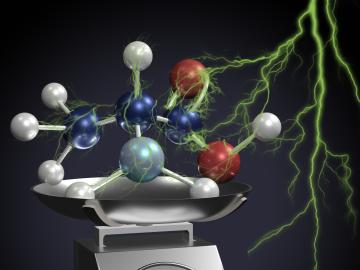
Filter News
Area of Research
- (-) Computer Science (12)
- (-) Energy Science (62)
- (-) Materials (48)
- Advanced Manufacturing (2)
- Biology and Environment (30)
- Computational Engineering (1)
- Energy Sciences (1)
- Fusion and Fission (2)
- Fusion Energy (2)
- Isotopes (1)
- Materials for Computing (3)
- National Security (15)
- Neutron Science (13)
- Nuclear Science and Technology (6)
- Quantum information Science (6)
- Supercomputing (86)
News Topics
- (-) Artificial Intelligence (11)
- (-) Computer Science (33)
- (-) Energy Storage (41)
- (-) Microscopy (18)
- (-) Molten Salt (3)
- 3-D Printing/Advanced Manufacturing (54)
- Advanced Reactors (6)
- Big Data (7)
- Bioenergy (22)
- Biology (3)
- Biomedical (8)
- Biotechnology (3)
- Buildings (12)
- Chemical Sciences (19)
- Clean Water (7)
- Composites (10)
- Coronavirus (9)
- Critical Materials (7)
- Cybersecurity (7)
- Environment (42)
- Exascale Computing (2)
- Fossil Energy (1)
- Fusion (5)
- Grid (23)
- High-Performance Computing (1)
- Hydropower (1)
- Irradiation (1)
- Isotopes (10)
- Machine Learning (12)
- Materials (46)
- Materials Science (68)
- Mathematics (2)
- Mercury (2)
- Microelectronics (1)
- Nanotechnology (28)
- National Security (3)
- Neutron Science (31)
- Nuclear Energy (19)
- Partnerships (9)
- Physics (22)
- Polymers (15)
- Quantum Computing (2)
- Quantum Science (9)
- Security (5)
- Simulation (2)
- Space Exploration (3)
- Summit (5)
- Transportation (41)
Media Contacts

Oak Ridge National Laboratory scientists analyzed more than 50 years of data showing puzzlingly inconsistent trends about corrosion of structural alloys in molten salts and found one factor mattered most—salt purity.

OAK RIDGE, Tenn., Jan. 31, 2019—A new electron microscopy technique that detects the subtle changes in the weight of proteins at the nanoscale—while keeping the sample intact—could open a new pathway for deeper, more comprehensive studies of the basic building blocks of life.

Oak Ridge National Laboratory scientists studying fuel cells as a potential alternative to internal combustion engines used sophisticated electron microscopy to investigate the benefits of replacing high-cost platinum with a lower cost, carbon-nitrogen-manganese-based catalyst.

Scientists at the Department of Energy’s Oak Ridge National Laboratory used neutrons, isotopes and simulations to “see” the atomic structure of a saturated solution and found evidence supporting one of two competing hypotheses about how ions come

An Oak Ridge National Laboratory-led team used a scanning transmission electron microscope to selectively position single atoms below a crystal’s surface for the first time.

Sergei Kalinin of the Department of Energy’s Oak Ridge National Laboratory knows that seeing something is not the same as understanding it. As director of ORNL’s Institute for Functional Imaging of Materials, he convenes experts in microscopy and computing to gain scientific insigh...

A new microscopy technique developed at the University of Illinois at Chicago allows researchers to visualize liquids at the nanoscale level — about 10 times more resolution than with traditional transmission electron microscopy — for the first time. By trapping minute amounts of...

Oak Ridge National Laboratory scientists have developed a crucial component for a new kind of low-cost stationary battery system utilizing common materials and designed for grid-scale electricity storage. Large, economical electricity storage systems can benefit the nation’s grid ...

The U.S. Department of Energy’s Oak Ridge National Laboratory today unveiled Summit as the world’s most powerful and smartest scientific supercomputer.
For the past six years, some 140 scientists from five institutions have traveled to the Arctic Circle and beyond to gather field data as part of the Department of Energy-sponsored NGEE Arctic project. This article gives insight into how scientists gather the measurements that inform t...


